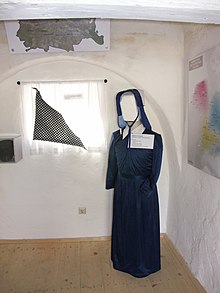Anabaptist Museum in Niedersulz

The Niedersulz Anabaptist Museum was opened in 2008 in the museum village of Niedersulz . It is the first museum in Austria with a permanent exhibition on the history of the Hutterites and Anabaptists with a focus on the Weinviertel and South Moravia .
History of the Kleinhäuslerhaus
The Kleinhäuslerhaus appears for the first time in 1600 and 1774 in the register of the Wilfersdorf rule as "Zuleuthstübl". From 1750 to 1819 it was entered in the land register as a "small house", a residential building with room and chamber, with stables, garden and shared pasture. In 2007 it was bought by Josef Hienerth, who initiated the transfer to the museum village . The small house was in a typical location for its function on the edge of the village. Because of its location on a slope in the Kellergasse , parts of the stables and storage rooms were dug into the mountain. Despite the cramped space conditions, the typical L-shape in the Weinviertel can be seen: a courtyard with the transverse residential wing, to which a short longitudinal wing with the stables connects. When the house was transferred, these particularities were addressed.
These rooms now house the first permanent exhibition on the history of the Hutterites, a Reformation religious movement that settled in the Liechtenstein possessions in southern Moravia and the adjacent Weinviertel region around 1528.
The Hutterites and the Weinviertel
The movement of the Hutterites goes back to the Tyrolean Jakob Hutter , who sought a religious renewal in the tradition of Balthasar Hubmaier . The followers should decide freely and confirm this with a new baptism, hence the name Anabaptist. The principles were pacifism , community of property and the separation of church and state. Their refusal to take an oath of allegiance made them suspicious of many rulers and led to persecution. The Hutterites found refuge in the Protestant areas of Moravia , especially around Nikolsburg . There, the brothers in faith lived in Bruderhöfe with up to 500 residents. Around 25,000 Hutterites lived in Moravia. Because of their serious work, the Hutterites became excellent craftsmen. The special kind of Habaner ceramics, white tin glaze decorated with strong colored ornaments, was considered holiday ceramics in middle-class households and is still cultivated in the Moravian region today.
Finally, the Protestant nobles could no longer give the Hutterites sufficient protection. The Habsburg rulers demanded extradition from the Moravian territories and when Franz von Dietrichstein became cardinal in Nikolsburg in 1622 , persecution began here too. A collection of poems, the Falkensteiner Lieder, reports on such persecution and flight. They are sung in Canada to this day .
After the Battle of White Mountain , the Hutterites were expelled and settled in today's Slovakia . These settlements are partially preserved in the Habaner Hof . After migrating to Russia , the Hutterites moved to the New World. Their descendants, around 50,000 people, now live on Bruderhof farms in Canada and the USA . They maintain their original language to this day , which sounds similar to the Carinthian dialect.
Creation of the Anabaptist Museum
The Anabaptist Museum was founded in cooperation between the museum village of Niedersulz and the Hutterite History Association and was set up under the scientific direction of the historian and Anabaptist researcher Astrid von Schlachta . The museum was opened on October 5th, 2008.
The museum documents the history of the Anabaptists and traces their traces in the Weinviertel and neighboring South Moravia. It shows examples of the high quality craftsmanship of the Anabaptists and exhibits Haban ceramics.
Installations document the persecution of the Hutterites. The Falkensteiner Lied, which is sung to this day, is presented in excerpts. Audio installations give examples of the current Hutterite German .
bibliography
- Reinhold Eichinger, Josef F. Enzenberger: Anabaptists, Hutterites and Habaners in Austria: Anabaptist Museum Niedersulz , VTR Nuremberg 2011, ISBN 978-3-941750-27-2 (museum guide)
- Reinhold Eichinger, Josef F. Enzenberger: Anabaptists, Hutterites and Habans in Austria: Anabaptist Museum Niedersulz , VTR Nürnberg 2012, ISBN 978-3-941750-28-9 (museum guide)
Web links
Coordinates: 48 ° 29 ′ 1.96 " N , 16 ° 40 ′ 33.8" E
